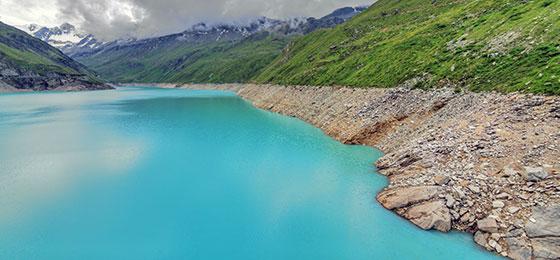Improving hydropower through long-range drought forecasts

Researchers at the Swiss Federal Institute for Forest, Snow and Landscape Research (WSL) have developed a complex hydrological model for forecasting dry spells lasting several weeks with high spatial resolution. These predictions make it possible, for example, to operate hydropower plants more profitably.
Changing climatic conditions pose extra challenges for hydropower plant operators. As part of the National Research Programme “Energy Turnaround” (NRP 70), researchers at WSL, MeteoSwiss and ETH Zurich have now developed a complex hydrological model that enables spatially detailed forecasts of persistent dry spells using real-time data. This allows reliable predictions of water scarcity over a period of up to three weeks.
Massimiliano Zappa of WSL, who heads the project, explains the advantage of such forecasts: “With climate change, dry spells will become more frequent and intensive, and will last longer.” Detecting these periods reliably is important for many reasons: long-range drought forecasts benefit agriculture and inland waterway transport; authorities could encourage people to conserve water at an early stage, or could save fish from rivers where water is low or too warm. This information is particularly useful for operators of reservoir power stations. “But up to now, forecasts have generally not been made over such long periods because of the high complexity and enormous amounts of data”, says Zappa.
Drought is easier to predict than precipitation, which can only be reliably forecasted up to five days at most. But dry spells are complex phenomena that depend on numerous climatic processes and regional factors such as intensity of water use, soil storage properties, expected soil moisture, water runoff and underground water reservoirs. Previously, Switzerland had no system capable of monitoring these local variables efficiently.
Making optimal use of available water
Long-range forecasts of inflow and outflow in the catchment areas of hydropower stations can be combined with predictions of price developments on the energy market to optimise operation and profitability. Up to now, hydropower operators had to rely on simple statistics such as multi-year averages of precipitation and runoff. The new procedure, however, allows them to estimate the water availability of each day of the following month. “Reservoir power stations can generate up to 4 per cent higher earnings by making optimal use of available water on the basis of long-range forecasts. This is very important for the hydropower industry, which has come under pressure”, says Frédéric Jordan, CEO of Hydrique Ingéniers, the industrial partner responsible for the economic calculations.
It is in society’s interest that hydropower plants be able to predict the availability of water and convert the stored water into electricity when market demand is high. Only when hydropower plants can operate profitably even under changing climatic conditions will it be possible to finance modernisation and expansion, as envisaged by the Energy Strategy 2050, from their own resources.
Contact
Dr Massimiliano Zappa
Eidgenössische Forschungsanstalt für Wald, Schnee und Landschaft WSL
Zürcherstrasse 111
8903 Birmensdorf
Tel.: +41 (0)44 739 24 33
E-Mail
The National Research Programmes “Energy Turnaround” (NRP 70) and “Managing Energy Consumption” (NRP 71)
The Swiss National Science Foundation’s National Research Programmes “Energy Turnaround” (NRP 70) and “Managing Energy Consumption” (NRP 71) are investigating the scientific and technological as well as socioeconomic aspects of the successful implementation of the Energy Turnaround. Until the end of 2018, more than 300 researchers in more than 100 research projects will be working on substantially reducing energy consumption, developing new technologies and evaluating social prerequisites for their implementation in the next 10 to 30 years.
NFP 70 and NFP 71 are running concurrently. Owing to their many overlapping areas of interest, the two programmes are closely coordinated.
Further information on the individual research projects and the organisation of the National Research Programmes is available at www.nrp70.ch and www.nrp71.ch.